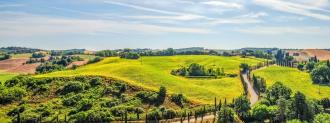The red and white, the blush, the still, and the sparkling — they are all, above all, agricultural products.
As Wine Enthusiast points out, wines are the end result of the area and climate in which they are grown, their terroir. So important is their environment that some wines come not only from certain countries exclusively, but certain regions within countries.
And like all agricultural products, wine production faces major challenges in climate change.
“Wine grapes are extremely sensitive to climate and this is much of what makes wine so exquisite,” Elizabeth M. Wolkovich, associate professor of Forest & Conservation at the University of British Columbia, told Wine Enthusiast. “But it also means wine grapes are extremely sensitive to climate change.”
As wine regions become hotter, dryer, and less hospitable, new varieties may need to be cultivated to keep your face flush.
Researchers at UC Davis examined grapes from regions of high water stress to see what traits could help keep wine production going in the face of climate change.
“The relationships between grape varieties and regions have historically been based on wine, without considering traits that affect drought or heat tolerance,” UC Davis Department of Viticulture and Enology associate professor, and lead author, Megan Bartlett said in a press release.
What they discovered is good news, for all current and future wine aficionados.
“These findings show these varieties could be more resilient to climate change than expected.”
Hot and Bothered
In grapes, as in great leaders, a bit of hardship early on can produce dividends later. Per UC Davis, grapes who face some water stress produce better wine, as it concentrates flavors and aromas. If they face too dry a climate, however, the delicate balance of acids, sugars, and tannins can be thrown off, producing lackluster vintages.
Grapes use their stomata to adjust to their climate conditions. Tiny pores found on the leaves, stomata take in carbon dioxide for photosynthesis and control how much water evaporates from the leaves.
Grapevines must conduct a balancing act: keep the stomata open, producing sugars for growth, or close the stomata and keep as much water inside as they can.
The UC Davis team evaluated 34 different varieties of grapes, focusing on European regions.
Most grape cultivars are chosen for their reproductive qualities, the team wrote in the Journal of Experimental Botany. But they wanted to focus instead on the physiological traits that may best help wine producers weather climate change; what helps some grapes thrive where others would wilt?
According to the release, they found that the stomata played a key role. Grapes from regions where water stress is more common, like Montepulciano and Sangiovese in Italy, keep their stomata closed more often than those in cooler, wetter climes.
“This strategy would help these varieties save water,” study co-author Gabriela Sinclair said in the release.
In other words, to help their regions adapt, wine growers may need to be examining grapevine’s stomata regulation more closely.
It’s not quite that simple, however. Grapevines use evaporation to keep cool, akin to human sweating; if you select grapes who are too tight on the stomata, you just may end up with grapes who sacrifice photosynthesis and cut back on the sugars they need to ripen (and ferment!).
“We have more work to do to understand how these traits will affect grapevines as the climate reaches new extremes,” Bartlett said. “These findings show that traits will be important to consider when we predict what will happen to different wine regions.”
A New Map
Already those regions are shifting. Take, for example, the rise of the English sparkling wine, the bubbly benefit of a warming island.
“As the climate has warmed, regions that were once considered too cold are now demonstrating that they, too, can produce fine wine, as long as the other elements are in order,” the New York Times’ Eric Asimov wrote in 2019. “In pursuit of the best sites, wine producers are moving north in the Northern Hemisphere, and south in the Southern.”
It’s not all feel-buzzed stories of new markets, however; a study in PNAS estimates that a two degree Celsius rise in temperature could shrink optimal wine growing regions by over half. (Better grab a glass before you see what they think a four degree rise could do.)
But wine grapes have some advantages that make them the perfect study subject; according to the Earth Institute at Columbia University, wine grapes are “extremely diverse — there are more than 1,100 different varieties planted today, growing under a wide range of conditions — and well-documented, with harvest data stretching back centuries.”
They are also, for good and for ill, quite sensitive little things.
Diversity in grapes may be key to keeping us happily popping corks into the future, and the stomata-clenching traits identified by UC Davis could be one of the key attributes for future growers to consider.






